There’s no doubt that one of the most popular sizes and designs sold for production alloy trailer boats is cabin boats around 5.5m. We look at some of the many options available on the market, with an advertised length overall of between 5.4m to 5.6m.

Buying a boat in this category, (5.3-5.6m cabin/cuddy cabin) be it new or secondhand, can be a daunting task, especially for those of you who are not regular trailer boaters, more especially if you are first-time purchasers. The salesman will extol all the virtues of a particular model, that may (or may not) suit your purpose exactly. But how do you really know?
Amongst the first things to determine is what style of 5.5m cabin boat do you require and probably more importantly what’s your budget? As for the style of boat there are a number of clearly defined categories, e.g. cuddy cabin, full cabin and hardtop.

The most popular is the traditional cabin boat. These account for the majority of all production aluminium trailer-boats built in New Zealand. The cabin boat also comes in a number of forms, from what is referred to as the full cabin, where the cabin space allows for two berths of up to about 1.8m in length. Options such as lockable cabin doors and full bulkheads are also available, although can be a bit restrictive in a boat around 5.5m, so are not common
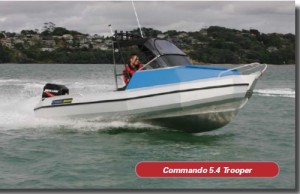
Then there is the cuddy cabin, which has a smaller cabin and larger cockpit, with the cabin more useful as an area to stow your gear and somewhere to sit out of the weather. This is a popular style in boats designed with a fishing aspect, when workable cockpit space is more important than is somewhere to lie down.
One of the growing trends, especially in boats over 6m is the hardtop, which comes in either fully or semi enclosed layout. These are not so common however in boats under 6m due to the space restrictions, but there are a number of builders offering this option. They are more targeted towards the serious fisho who wants a boat that offers the necessary protection in almost any weather.
Choosing your Cabin Boat
Aluminium boats in New Zealand have a reputation for solid construction and hull thickness and are traditionally 3mm to 5mm and even 6mm depending on the boat’s size. Metre for metre an aluminium boat is lighter than a fibreglass boat so has the advantage of requiring less horsepower to achieve a similar performance and is also therefore lighter to tow.
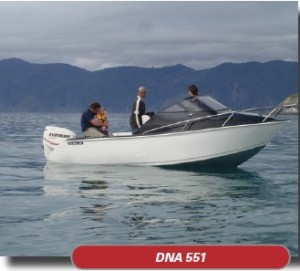
Aluminium also has a reputation of being capable of handling more abuse, is stronger and requires less maintenance. Unfortunately all that’s not entirely true. Aluminium still needs the same care and attention as fibreglass, in fact if it’s unpainted, it requires more if you want to maintain that ‘as new shine’. A handy hint is
if you buy an unpainted aluminium boat, coat it in a product such as Nyalic and that shine will stay on the boat for a lot longer.
Aluminium left to weather not only looks bad, it also causes hidden problems with areas under the cockpit sole, in welded joints and bonded areas. However, like fibreglass, if you make a habit of washing the boat down after use with soapy water, then you won’t have a problem. Painted aluminium is now more popular than unpainted and this does require special care, especially if you scratch the hull.
The latest trend is wrapping, which involves covering the hull sides with a ultra strong self-adhesive vinyl, that will not fade or go cloudy like paint. You can also go wild with fancy graphics and images if you really want to individualise your boat.

As for strength, well maybe if you run up on some rocks at speed you will only dent the hull and not punch a hole in the bottom, but generally a fibreglass boat will take as much punishment as an aluminium one. Aluminium boats are certainly flavour of the moment with fishers, but with manufacturers now producing high spec examples that are unashamedly pitched directly at similar sized fibreglass boats, the market trends are changing.
Mono or Cat
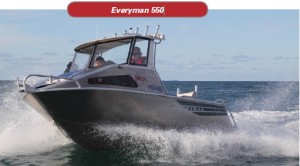
While the majority of production alloy boats available are conventional monohulls, there are also the twin hull or catamaran option. New Zealanders, unlike Australians have not taken to the catamaran theme, despite the huge space, stability and offshore handling advantages. The down side is they normally always require twin engines, the cabins are small and are the initial purchase price is considerably more than a monohull.
The 5.5m alloy monohull in most cases is based on a conventional hull shape with a deep vee forefoot, spray strakes in various configurations and wide chine flats, and a transom deadrise anywhere from 13 deg to 20 deg depending on the boat’s intended use.
Generally, the deeper the vee the better the ride in rougher water. There can however be a trade-off because a lightly laden deep vee hull, with its chines out or almost out of the water, is more often than not less stable at rest than a shallow vee. (This explains why aluminium hulls generally have less deadrise than GRP hulls.) This is not true however with rigid hulled buoyancy boats (pontoon) that due to the very nature of the hull design create their own stability whilst both underway and at rest.
Boat Size Matters
Another important consideration is the overall dimensions of the boat, taking in overall length of the boat on the trailer, total width from wheel guard to wheel guard and overall height. No good getting the boat home and finding you have to punch 1m out of the back of the garage into the kids’ spare room.
And of course where you are going to use the boat and for what purpose, is just as important. Will a boat of 5.4-5.6m suit the type of water conditions in the area that you propose to use the boat in, and look only at boats that you feel would be practical.
Boats around 5.5m, tend to be designed primarily for inshore areas and say what you like, staying away overnight in a boat under 6m is not the most comfortable! They are light, easy to tow behind a small car and require only mid size outboards in the 60hp – 115hp range.
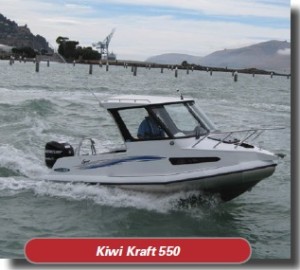
In most instances they are not suitable for rough water boating, although there are exceptions, especially from some of the aluminium rigid buoyancy hull – pontoonboat builders.
In the 5m – 6m range you have the widest selection and this is where your buying decision gets really confusing. The biggest selling alloy cabin boats in the country fall within this group. You are still in the realm of single axle trailers and towing weights in the 1400 – 1800 kg range.
Cabin Boat Power Options
The boat is only the first part of the buying equation, you also have to consider what you are going to power it with. While there are two choices, outboard or sterndrive, the majority of production boats under 6m are more likely to be outboard powered.
Buying an outboard isn’t as simple as it used to be, with the choice of 2-stroke or 4-stroke, direct injection, fuel injection or carburettor. The outboard technology is changing so quickly that at times it’s hard to keep up with what’s happening. With a worldwide move towards ‘things green’, 4-strokes and direct injection 2-stroke outboards are hot topics.
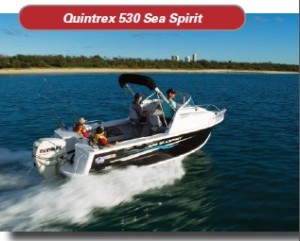
Package Buying
When it comes to deciding between brands, the choice can still be difficult, especially if a number of boats offer exactly what you want. If they are well known and reputable brands then the build quality, finish and resale value of the package shouldn’t be a consideration. If a boat carries a CPC (Construction Compliance Certification) plate then there’s a damn good chance you’ll have no problems with the construction and if you do at least there is some recourse to protect your investment.
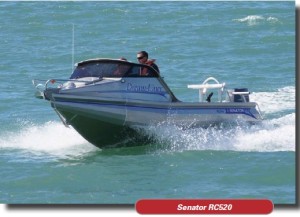
If you are purchasing a new rig it is more prudent to get it all from one retailer as a total package. This should not only include the boat/motor/trailer, but also everything from the lifejackets to the fishfinder. In most cases the dealer has the experience to set McLay 561 crossXover the boat up right and should pass it over to you in a keystart situation.
Also when buying a new or used boat check out exactly what you are paying for and exactly what the rig is going to cost you when it’s time to pay the final cheque. The initial $35,000 total package sticker may end up costing you $42,000 once you have added all the extras, e.g. canopy, underfloor tank, rod holders, road cover, rocket launcher, boarding ladder, and electronics. Not every boat comes with the same set of equipment in the standard package and what may sound cheap to start with could cost you a whole lot more in the end. Dealers are also able to offer excellent finance and insurance packages and if you have a trade there is also the added bonus of being able to put your old boat into the deal.
As boats are not registered, if you do buy privately do whatever you can to ensure that the person selling the boat actually owns it. Trailer registration plates are a good start, but not totally fool proof.
Buying a new or used aluminium boat can be a daunting task especially for a first-time buyer and with so many models on the market and the numbers growing every season it doesn’t get any easier.




